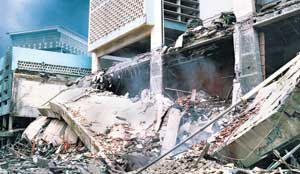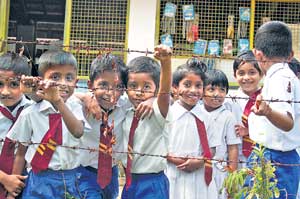Q-sera – What ever will be … will be!
On the 25th anniversary of the devastating 1983 July communal riots, The Sunday Times FT sought to piece together an analysis of what Sri Lanka - in terms of business, trade and the econony - would be today if there was no explosion of violence on that fateful day on Sunday, July 24.
The verdict – except for some advances in the economy, tourism and investment, communal tensions and disputes over Tamil rights would have still plagued the nation and an ethnic explosion of sorts may have occurred, sooner or later.
Business leaders said it was unlikely Sri Lanka would have become another Singapore as widely speculated if there was no riot in 1983.
Our team of reporters – Duruthu Edirimuni Chandrasekera, Dilshani Samaraweera, Bandula Sirimanna and Lakwi Perera – spoke to a cross-section of economists, business leaders, chamber personalities and a sociologist on what Sri Lanka would have been … if not for the conflict. |
|
While the social costs of ‘Black July’ have been a topic of wide discussion, the economic costs have been less prominent.
Since July 23, 1983, which this week marked the 25th anniversary of the Black July riots, the total economic loss, according to some estimates in 1998, is 1.27 times of Sri Lanka's Gross Domestic Product (GDP).
The Sunday FT spoke to four economists about the economic impacts of the violence and social unrest on the anniversary of Sri Lanka’s worst ethnic riot. The economists noted that Sri Lanka’s economic losses from social unrest were not limited to the incidents of 1983, and that these losses extended both before and after the date of July 23, 1983. However, the economists agreed that ‘Black July’ was a black day for the overall Sri Lankan economy for a number of reasons.
“The events of 1983 had wide impacts on the overall economy. So the economic impact was not just limited to a few sectors,” said Dr Upali Wickremasinghe, a lecturer of economics at the University of Sri Jayawardenapura.
FDI and Tourism
Tourism and foreign investments are noted as the hardest hit by the violent events of 1983. The impact on foreign investments, starting from 1983, is still being felt. “Black July was a black mark in deterring big names (foreign investors) from coming to Sri Lanka, and from acting as a trigger for others to follow them,” noted Dr Wickremasinghe.
“Foreign investors like Motorola, Harris and Sanyo were planning to invest here, but they pulled out after the riots.
These are not just big companies they are also big global names. So if they had entered the country, others would have followed,” explained the Head of the Institute of Policy Studies, Dr Saman Kelegama.
 Sri Lanka’s tourist industry is another victim that is yet to recover from 1983 and the years of turbulence that followed. “The tourism sector is another area that was affected. In 1982 arrivals were approaching the half million mark. Total arrivals for the year 1982 was already 407,230. Today, we are still in the half-million area. So if not for the start of that period of unrest from ’83, we could be getting 5 million tourists per year by now,” said Dr Kelegama. Sri Lanka’s tourist industry is another victim that is yet to recover from 1983 and the years of turbulence that followed. “The tourism sector is another area that was affected. In 1982 arrivals were approaching the half million mark. Total arrivals for the year 1982 was already 407,230. Today, we are still in the half-million area. So if not for the start of that period of unrest from ’83, we could be getting 5 million tourists per year by now,” said Dr Kelegama.
North and East
The economic fallout of the widespread massacre of Tamils that broke out in July 1983 is still being felt in the North and East. Economist from the Colombo University, Dr. Sirimal Abeyratne said traditional economic activities such as farming will revive in the North and East but the economy above that level remains stagnant.
In addition to the killing of Tamils which Dr. Abeyratne estimated to be around 75,000 spanning the several decades of the ethnic conflict, he also said that the thousands more who fled the country after the events in July 1983 drove out a large chunk of skilled and trained workers and professionals from the country.
Estimates of the number of Tamils who were killed in July 1983 range from 1000 to 5000 according to various publications available on the Internet.
The North and East lost its investor class along with its capital assets in terms of infrastructure in addition to its skilled labourers. Dr. Abeyratne also pointed out that they lost their institutions on a grassroot and regional level resulting in the loss of rule of law, regulations, norms and values.
He added that the population that remains are the poor who are helpless and unable to make a substantial contribution to economic growth today.
Even if there is peace in the region, Dr. Abeyratne said the impact of the events in 1983 and the ongoing war, may prove to be too great a burden to overcome in order to develop the economy that is needed for sustainable growth without considerable investments.
He said that even the Central Bank has stated in the past that investment in the North and East should have been 2% higher than what it has been over the past 20 years.
Growth, regardless
However, despite these economic drawbacks of conflict, the Sri Lankan economy has managed to maintain an impressive annual growth of around 5%, on average. Economists point to the combined effects of private sector exports and government investments, for this economic resilience.
“Growth rates dropped to about 1% to 2% during the period of the second JVP riots. But during the early ‘80s there was high growth. This growth was achieved mainly through our exports, because we started from a low level. Programmes like the Mahaweli, with its massive capital investment, also contributed,” said Dr Kelegama.
Services too, continued to grow in spite of the volatile environment. “Services growth is mainly due to increased construction activity and higher credit. For instance, when you talk of construction services, in addition to the Mahaweli Programme, there were also road and housing projects,” said Dr Wickremasinghe.
War economics
Sri Lanka’s war activities may also be contributing to growth - at least at a statistical level.
“It is possible to maintain growth while fighting a war because war is also an economic activity,” said Dr Athula Ranasinghe, senior lecturer of economics at the Colombo University.
“All formal economic activities are included in the GDP. So war expenses are also included in the GDP because public services and government expenses are included in the GDP. Of course, there are positive and negative impacts of the war and the destruction from war can contribute towards reducing GDP. But to what extent the loss of capital is accounted for, in calculating the national GDP, is not clear,” said Dr Ranasinghe.
Slowing down
The current global economic slowdown is expected to put a damper on Sri Lanka’s prevailing growth momentum as well. “Our growth is now above 6%, but in the coming years this will slow down due to the economic slow down globally,” said Dr Kelegama.
Brain drain a serious problem over many decades
By Lakwi Perera
 Brain drain from Sri Lanka is a large problem and until it is addressed in the mainstream public discourse, it will continuously plague the country, Professor S. T. Hettige, Chair of Sociology at the University of Colombo told The Sunday Times FT. Brain drain from Sri Lanka is a large problem and until it is addressed in the mainstream public discourse, it will continuously plague the country, Professor S. T. Hettige, Chair of Sociology at the University of Colombo told The Sunday Times FT.
The eminent sociologist noted that migration of professionals had occurred over time for various reasons. The first wave was in the late 1950s when Sinhala was made the official language and educated minorities left the country. The closed economy in the early 1970s also led many professionals, irrespective of ethnicity, out of the country towards greener pastures.
After 1983 Sri Lanka became very vulnerable. The shock affected everyone, especially the Tamil community who left the country in droves. “We haven’t settled down since then,” he said. One of the main reasons Sri Lanka has maintained economic growth is because of the involvement of the private sector especially after privatization of certain organizations. Owners of these organizations had no choice but to make companies work and that has kept the economy going.
Prof Hettige noted that there has been a rapid acceleration of labour migration since 1977 and currently Sri Lanka has a migrant labour force of over 1.5 million who send in over three billion US dollars annually. This is what is used to cover around 60% of the trade deficit. “Just imagine where the country and the government would be if not for this money coming in every year,” he asked. This money is being spent on various items and this is pushing the economy.
Some of the main implications of brain drain is financial drain, loss of investment of money and the country losing competent, qualified professionals who are needed in every sector and industry.
“It is ironic that people who go out of the country temporarily for work send money into the country, helping the economy whereas the professionals who go out leading to brain drain take with them money that they had in the country, creating an outward flow of money,” he said.
When professionals who were educated at public expense migrate, take their expertise with them the country loses its investments as well. “How can you develop a country without professionals and expertise?” he asked, adding that many countries, especially in Asia that developed like Singapore, Malaysia, India and now China did so because of the expertise the countries possessed. Those countries invested more in their human resources more that Sri Lanka did and they don’t have an outflow of experts as severe as this country has had. “We cannot produce experts to match the rate at which they leave,” Prof Hettige said.
The brain drain is felt in all sectors of the economy and no area has been spared. Taking the example of education, he lamented the fact that there are many unqualified and mediocre individuals filling important positions in the higher education sector. It is the same with general education, he added. “The country has about 200,000 teachers but how many of them are at least bi-lingual?” he asked.
The public service is still lagging behind and is inefficient and unproductive. Modern methods of administration and transaction have not been introduced and people still have to queue in Colombo to get most of their work done.
Prof Hettige says Sri Lankans are living in uncertain times and turn to religion and superstition to help through various ‘crises’. “That is the reason we see a huge upsurge of religiosity (too religious),” he noted. Professionals with qualifications and even skilled people can easily leave the country, which is what they do.
He questioned the practicality of the policies of sending skilled labour as migrant labour. “Are you implying that the country can grow and develop with unskilled labour? When you send skilled labour out who is going to do the work here” he asked. This is another example of the here and now way of thinking which is dominant in the country.
“We have an energy crisis in the country and a food crisis, where’s the big discussion on these?” he asked, concluding that it boils down to the fact that there are very few competent people in the country due to brain drain. |
